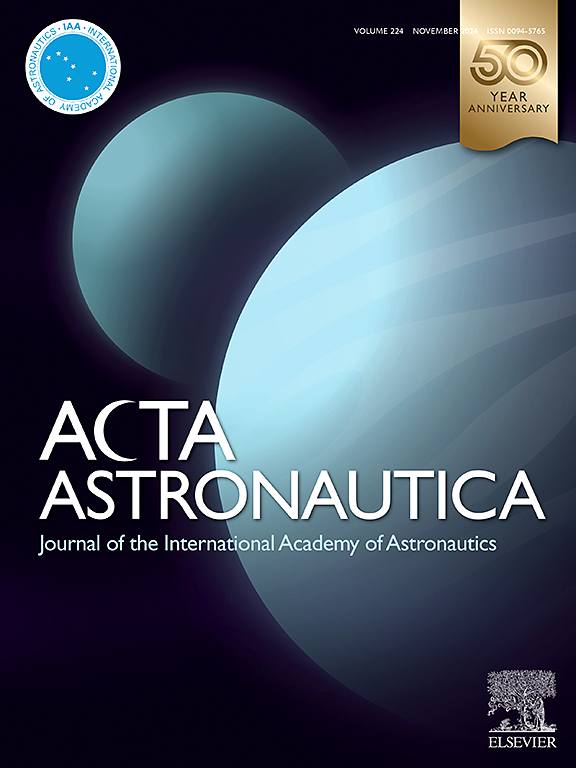The influence of confined channel configuration on the detonation waves induced by hot jet under supersonic pulsating flow
IF 3.1
2区 物理与天体物理
Q1 ENGINEERING, AEROSPACE
引用次数: 0
Abstract
The detonation engine combustion chamber represents a typical confined channel, whose operational stability is significantly influenced by the coupling effects between complex inlet shock structures and combustion chamber backpressure fluctuations. Based on supersonic pulsating inflow simulating practical conditions, this work delves into detonation propagation characteristics and mechanisms through examining three confined channel configurations: rectangular channel, expanding channel, and cavity-coupled expanding channel. Numerical calculations are performed using a hybrid sixth-order weighted essentially non-oscillatory centered difference scheme and a one-step, two-species hydrogen-oxygen finite-rate chemistry model. The results reveal that, compared to the rectangular channel, the expanding channel exhibits enhanced disturbances, generating separated oblique shock waves. These shock waves reduce the detonation wave length and stability, leading to severe attenuation in later stages. In the cavity-coupled expanding combustion chamber, pressure oscillation waves advance the initiation time and increase both propagation time and distance, thereby enhancing detonation stability through intensified shock reflections and unburned gas mixing. Notably, increasing the cavity length strengthens the pressure oscillation waves and widens the subsonic channel ahead of the cavity. However, when the length-to-depth ratio exceeds 2.5, flow field instability induced by bifurcated unburned jets is identified as causing abnormal detonation wave recession. Therefore, optimizing the length-to-depth ratio to 2.0–2.5 achieves a balance between stability and structural compactness, maximizing performance benefits. The findings support optimized combustion chamber designs for detonation-based propulsion systems.
超声速脉动流条件下密闭通道构型对热射流诱导爆震波的影响
爆震发动机燃烧室是一个典型的密闭通道,复杂的进气道激波结构与燃烧室背压波动之间的耦合作用对其运行稳定性影响很大。本文在模拟实际条件的基础上,通过对矩形通道、膨胀通道和空腔耦合膨胀通道三种密闭通道构型的研究,探讨了超声速脉动流爆轰传播特性和机理。数值计算使用混合六阶加权基本上非振荡中心差分格式和一步,两种氢-氧有限速率化学模型进行。结果表明,与矩形通道相比,膨胀通道表现出增强的扰动,产生分离的斜激波。这些激波减少了爆轰波的长度和稳定性,导致后期的严重衰减。在腔型耦合膨胀燃烧室中,压力振荡波提前了起爆时间,增加了传播时间和传播距离,从而通过增强激波反射和未燃气体混合增强爆震稳定性。值得注意的是,增加空腔长度增强了压力振荡波,并拓宽了空腔前方的亚音速通道。然而,当长深比超过2.5时,分叉未燃射流引起的流场不稳定被认为是引起爆震波异常衰退的原因。因此,将长深比优化到2.0-2.5可以在稳定性和结构紧凑性之间取得平衡,从而最大限度地提高性能效益。研究结果支持了基于爆轰推进系统的燃烧室优化设计。
本文章由计算机程序翻译,如有差异,请以英文原文为准。
求助全文
约1分钟内获得全文
求助全文
来源期刊

Acta Astronautica
工程技术-工程:宇航
CiteScore
7.20
自引率
22.90%
发文量
599
审稿时长
53 days
期刊介绍:
Acta Astronautica is sponsored by the International Academy of Astronautics. Content is based on original contributions in all fields of basic, engineering, life and social space sciences and of space technology related to:
The peaceful scientific exploration of space,
Its exploitation for human welfare and progress,
Conception, design, development and operation of space-borne and Earth-based systems,
In addition to regular issues, the journal publishes selected proceedings of the annual International Astronautical Congress (IAC), transactions of the IAA and special issues on topics of current interest, such as microgravity, space station technology, geostationary orbits, and space economics. Other subject areas include satellite technology, space transportation and communications, space energy, power and propulsion, astrodynamics, extraterrestrial intelligence and Earth observations.
 求助内容:
求助内容: 应助结果提醒方式:
应助结果提醒方式:


